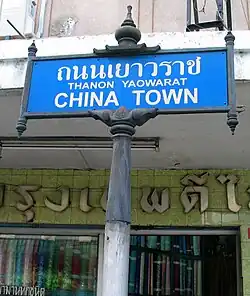Road signs in Thailand
Road signs in Thailand are standardized road signs similar to those used in other nations but much of it resembles road signage systems used in South American countries with certain differences, such as using a blue circle instead of a red-bordered white circle to indicate mandatory actions.[1] Until the early 1980s, Thailand closely followed American, European, Australian, and Japanese practices in road sign design, with diamond-shaped warning signs and circular restrictive signs to regulate traffic. For Romanized text, signs usually use the FHWA Series fonts ("Highway Gothic") typeface, which is used on American road signage, but for Thai text the font used is unknown.
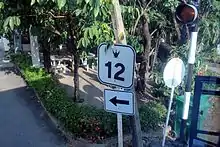



Thai traffic signs use Thai, the national language of Thailand, and distances and other measurements are expressed in compliance with the International System of Units. However, English is also used for important public places such as tourist attractions, airports, railway stations, and immigration checkpoints. Both Thai and Romanizations are used on directional signage.
Thailand is a signatory to the Vienna Convention on Road Signs and Signals, but has yet to fully ratify the convention.
History
The first year for road signs in Thailand was largely unknown, but it can be dated back as far as the start of the 1920s.
Thailand is the first country in Asia to adopt MUTCD standard yellow diamond warning signs, in 1940. For regulatory signs, rectangular signs were first used and were similar in design to North America, but they have been replaced in the mid-1950s by European-style red-bordered white circle signs.[2]
In 2004, mandatory signs were switched from South American design to European design.[3]
Regulatory signs
With the exception of the special designs used for Stop, Yield, and No Entry signs, mandatory signs (e.g., Must Turn Left) are round with a blue background, white border, and a white pictogram. Those which express a prohibition (e.g., No Left Turn) show the pictogram crossed out by a red diagonal bar. This is in accordance with the Vienna Convention on Road Signs and Signals (Type A variants).[4][5]
Priority Regulating Signs
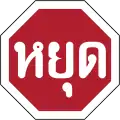 Stop (Thai language)
Stop (Thai language)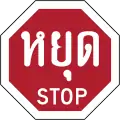 Stop (Thai and English languages)
Stop (Thai and English languages)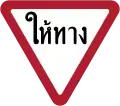 Give way (Thai language)
Give way (Thai language)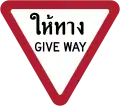 Give way (Thai and English languages)
Give way (Thai and English languages)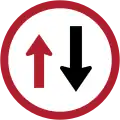 Give way to oncoming vehicles (used at traffic bottleneck points)
Give way to oncoming vehicles (used at traffic bottleneck points)
Prohibitory or Restrictive Signs
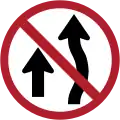 No overtaking
No overtaking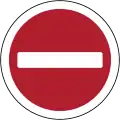 No entry
No entry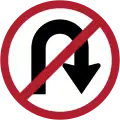 No right U-turn
No right U-turn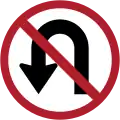 No left U-turn, Unused
No left U-turn, Unused No left turn
No left turn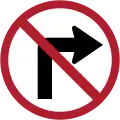 No right turn
No right turn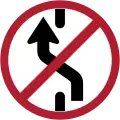 No changing to left lane
No changing to left lane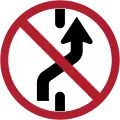 No changing to right lane
No changing to right lane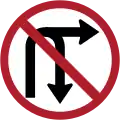 No right turn nor right U-turn
No right turn nor right U-turn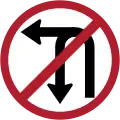 No Left Turn nor U-turn, Unused
No Left Turn nor U-turn, Unused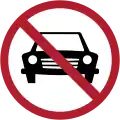 No cars
No cars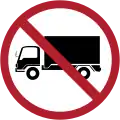 No trucks
No trucks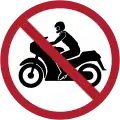 No motorcycles
No motorcycles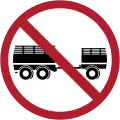 No trailers
No trailers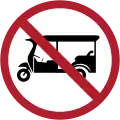 No tuk-tuks
No tuk-tuks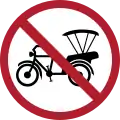 No tricycle
No tricycle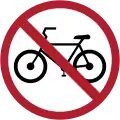 No bicycles
No bicycles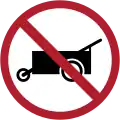 No carts
No carts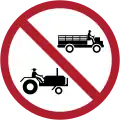 No tractors
No tractors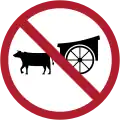 No animal-drawn carts
No animal-drawn carts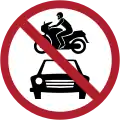 No motor vehicles
No motor vehicles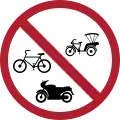 No tricycle or bicycles and motorcycles.
No tricycle or bicycles and motorcycles.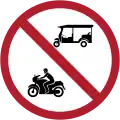 No motorcycles or moto-rickshaws
No motorcycles or moto-rickshaws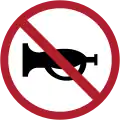 No honking
No honking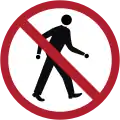 No pedestrians
No pedestrians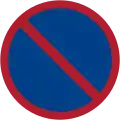 No parking
No parking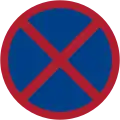 No stopping
No stopping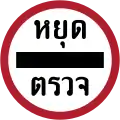 Stop at checkpoint (e.g.: customs, police)
Stop at checkpoint (e.g.: customs, police)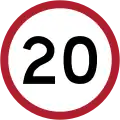 Speed limit (20 km/h)
Speed limit (20 km/h)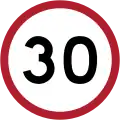 Speed limit (30 km/h)
Speed limit (30 km/h)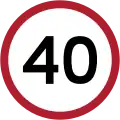 Speed limit (40 km/h)
Speed limit (40 km/h)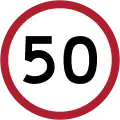 Speed limit (50 km/h)
Speed limit (50 km/h)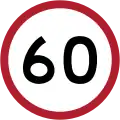 Speed limit (60 km/h)
Speed limit (60 km/h)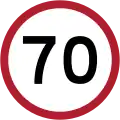 Speed limit (70 km/h)
Speed limit (70 km/h)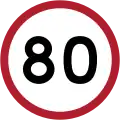 Speed limit (80 km/h)
Speed limit (80 km/h) Speed limit (90 km/h)
Speed limit (90 km/h)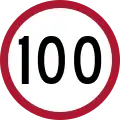 Speed limit (100 km/h)
Speed limit (100 km/h)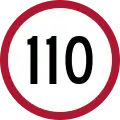 Speed limit (110 km/h)
Speed limit (110 km/h)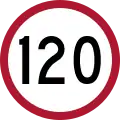 Speed limit (120 km/h)
Speed limit (120 km/h)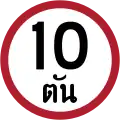 Weight limit
Weight limit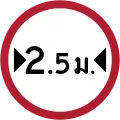 Maximum width
Maximum width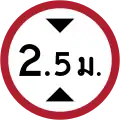 Maximum height
Maximum height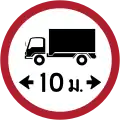 Maximum vehicle length (Thai language)
Maximum vehicle length (Thai language)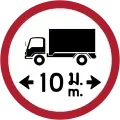 Maximum vehicle length (Thai and English languages)
Maximum vehicle length (Thai and English languages) No vehicles conveying dangerous goods
No vehicles conveying dangerous goods
Mandatory Signs
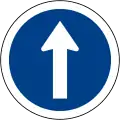 Go straight
Go straight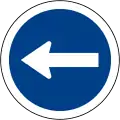 Turn left
Turn left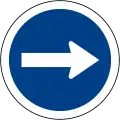 Turn right
Turn right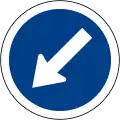 Keep left
Keep left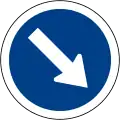 Keep right
Keep right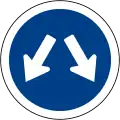 Pass on either side
Pass on either side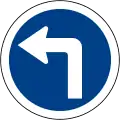 Turn left
Turn left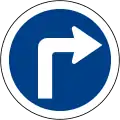 Turn right
Turn right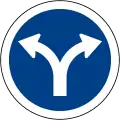 Turn left or right
Turn left or right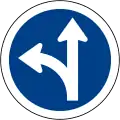 Go straight or turn left
Go straight or turn left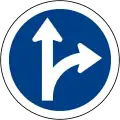 Go straight or turn right
Go straight or turn right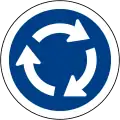 Roundabout
Roundabout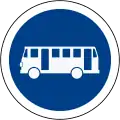 Buses only
Buses only High occupancy vehicles only
High occupancy vehicles only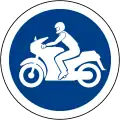 Motorcycles only
Motorcycles only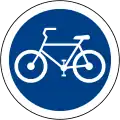 Bicycles only
Bicycles only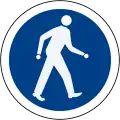 Pedestrians only
Pedestrians only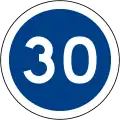 Minimum speed limit (30 km/h)
Minimum speed limit (30 km/h)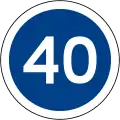 Minimum speed limit (40 km/h)
Minimum speed limit (40 km/h)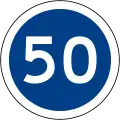 Minimum speed limit (50 km/h)
Minimum speed limit (50 km/h)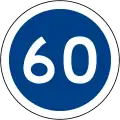 Minimum speed limit (60 km/h)
Minimum speed limit (60 km/h)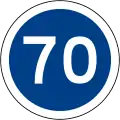 Minimum speed limit (70 km/h)
Minimum speed limit (70 km/h)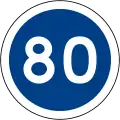 Minimum speed limit (80 km/h)
Minimum speed limit (80 km/h)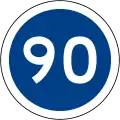 Minimum speed limit (90 km/h)
Minimum speed limit (90 km/h)
Other regulatory signs
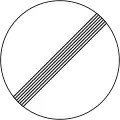 Speed limit zone ends
Speed limit zone ends
General regulatory signs
 Speed limit (In city – Bangkok, Pattaya and cities inbound)
Speed limit (In city – Bangkok, Pattaya and cities inbound) Speed limit (Countryside – Bangkok, Pattaya and cities outbound)
Speed limit (Countryside – Bangkok, Pattaya and cities outbound)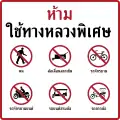 Prohibited on Motorways
Prohibited on Motorways Prohibited on Expressways
Prohibited on Expressways Slow traffic keep left
Slow traffic keep left Right lane passing only
Right lane passing only All cars use low gears
All cars use low gears Limited visibility, no overtaking
Limited visibility, no overtaking Wrong Way
Wrong Way Right lane only for U-turn
Right lane only for U-turn left lane, turn left
left lane, turn left Stop and wait for the signal here
Stop and wait for the signal here car speed rating
car speed rating Truck weight for rural roads
Truck weight for rural roads Truck weight for local highways
Truck weight for local highways
Superseded regulatory signs
These signs have been superseded, but are still around.
.svg.png.webp) Stop
Stop.svg.png.webp) No entry
No entry.svg.png.webp) No tractors
No tractors.svg.png.webp) Stop at checkpoint (e.g.: customs, police)
Stop at checkpoint (e.g.: customs, police).svg.png.webp) Speed limit (50 km/h)
Speed limit (50 km/h).svg.png.webp) Go straight
Go straight.svg.png.webp) Turn left
Turn left.svg.png.webp) Turn right
Turn right.svg.png.webp) Keep left
Keep left.svg.png.webp) Keep right
Keep right.svg.png.webp) Pass on either side
Pass on either side.svg.png.webp) Turn left
Turn left.svg.png.webp) Turn right
Turn right.svg.png.webp) Turn left or right
Turn left or right.svg.png.webp) Roundabout
Roundabout.svg.png.webp) End of speed limit
End of speed limit.svg.png.webp) End of overtaking prohibition
End of overtaking prohibition
Warning signs
Thai warning signs are diamond-shaped and are yellow and black in colour.[6]
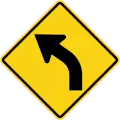 Curve to left
Curve to left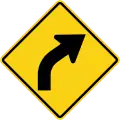 Curve to right
Curve to right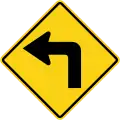 Sharp curve to left
Sharp curve to left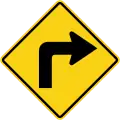 Sharp curve to right
Sharp curve to right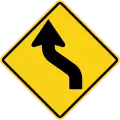 Double curve, first to left
Double curve, first to left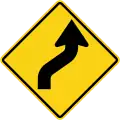 Double curve, first to right
Double curve, first to right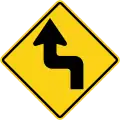 Sharp double curve, first to left
Sharp double curve, first to left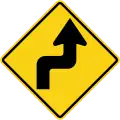 Sharp double curve, first to right
Sharp double curve, first to right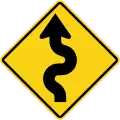 Winding road, first bend to left
Winding road, first bend to left Winding road for next --- km, first bend to left
Winding road for next --- km, first bend to left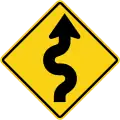 Winding road, first bend to right
Winding road, first bend to right Winding road for next --- km, first bend to right
Winding road for next --- km, first bend to right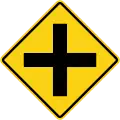 Crossroads
Crossroads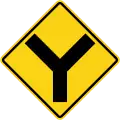 Y-junction
Y-junction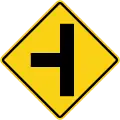 Side road junction on left
Side road junction on left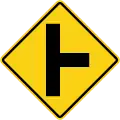 Side road junction on right
Side road junction on right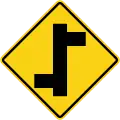 Offset road junction, left and right
Offset road junction, left and right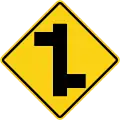 Offset road junction, left and right
Offset road junction, left and right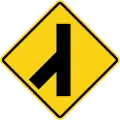 Skewed side road junction on left
Skewed side road junction on left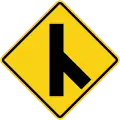 Skewed side road junction on right
Skewed side road junction on right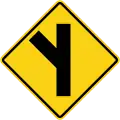 Skewed side road junction on left
Skewed side road junction on left Skewed side road junction on right
Skewed side road junction on right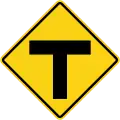 T-junction
T-junction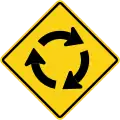 Roundabout
Roundabout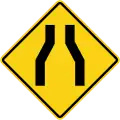 Road narrows on both sides
Road narrows on both sides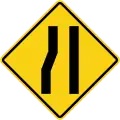 Road narrows .on left side
Road narrows .on left side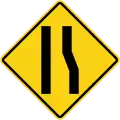 Road narrows on right side
Road narrows on right side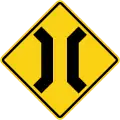 Narrow bridge
Narrow bridge Narrow bridge - give way to oncoming vehicles (used at traffic bottleneck points)
Narrow bridge - give way to oncoming vehicles (used at traffic bottleneck points)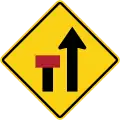 Left lane ends
Left lane ends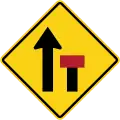 Right lane ends
Right lane ends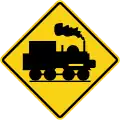 Railway crossing ahead without gates
Railway crossing ahead without gates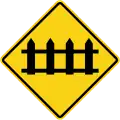 Railway crossing ahead with gates
Railway crossing ahead with gates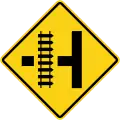 Railway crossing on next side road
Railway crossing on next side road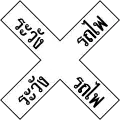 Railroad crossing
Railroad crossing Width restriction ahead (Thai language)
Width restriction ahead (Thai language)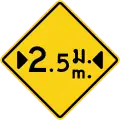 Width restriction ahead (Thai and English languages)
Width restriction ahead (Thai and English languages)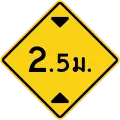 Height restriction ahead (Thai language)
Height restriction ahead (Thai language)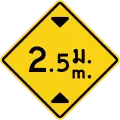 Height restriction ahead (Thai and English languages)
Height restriction ahead (Thai and English languages)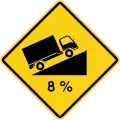 Steep climb
Steep climb Steep climb for next --- km
Steep climb for next --- km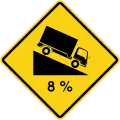 Steep descent
Steep descent Steep descent for next --- km
Steep descent for next --- km Steep descent – use low gear (Thai language)
Steep descent – use low gear (Thai language) Steep descent – use low gear (Thai and English languages)
Steep descent – use low gear (Thai and English languages)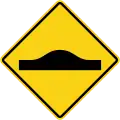 Hump
Hump Speed Hump
Speed Hump Uneven road
Uneven road Speed uneven
Speed uneven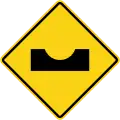 Dip
Dip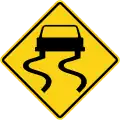 Slippery road
Slippery road Slippery road
Slippery road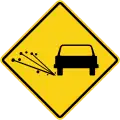 Loose road surface
Loose road surface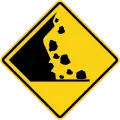 Falling rocks
Falling rocks Slippery road when wet
Slippery road when wet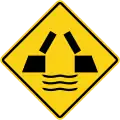 Opening bridge
Opening bridge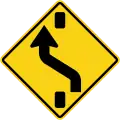 Shift to left carriageway
Shift to left carriageway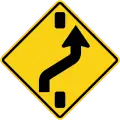 Shift to right carriageway
Shift to right carriageway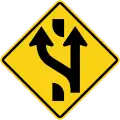 Added lane ahead
Added lane ahead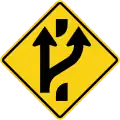 Added lane ahead
Added lane ahead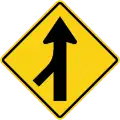 Left merging traffic
Left merging traffic Merging traffic - beware cars from the left
Merging traffic - beware cars from the left Right merging traffic
Right merging traffic Merging traffic - beware cars from the right
Merging traffic - beware cars from the right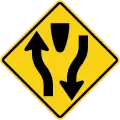 Divided road begins
Divided road begins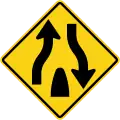 Divided road end
Divided road end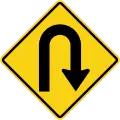 Hairpin curve to Left
Hairpin curve to Left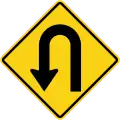 Hairpin curve to Right
Hairpin curve to Right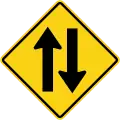 Two-way traffic
Two-way traffic Two-way traffic
Two-way traffic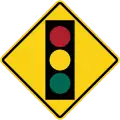 Traffic lights Ahead
Traffic lights Ahead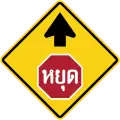 Stop ahead (Thai language)
Stop ahead (Thai language)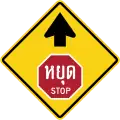 Stop ahead (Thai and English languages)
Stop ahead (Thai and English languages)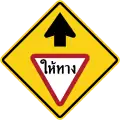 Give way ahead (Thai language)
Give way ahead (Thai language)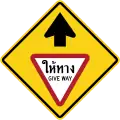 Give way ahead (Thai and English languages)
Give way ahead (Thai and English languages) Crossroad Intersection-1
Crossroad Intersection-1 Traffic lights Ahead intersection-2
Traffic lights Ahead intersection-2 Traffic lights Ahead Intersection-3
Traffic lights Ahead Intersection-3 Railway crossing ahead without gates-1
Railway crossing ahead without gates-1 Railway crossing ahead without gates-2
Railway crossing ahead without gates-2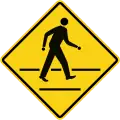 Pedestrian crossing
Pedestrian crossing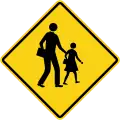 Children
Children School zone
School zone.svg.png.webp) School 200 m.
School 200 m.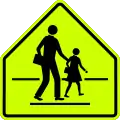 School zone (In Bangkok local highway zone)
School zone (In Bangkok local highway zone)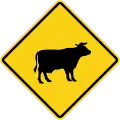 Animals Ahead
Animals Ahead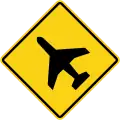 Low-flying aircraft
Low-flying aircraft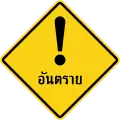 Other danger (Thai language)
Other danger (Thai language)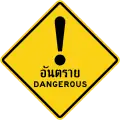 Other danger (Thai and English languages)
Other danger (Thai and English languages)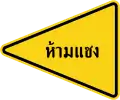 No overtaking zone
No overtaking zone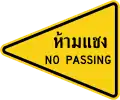 No overtaking zone (Thai and English languages)
No overtaking zone (Thai and English languages)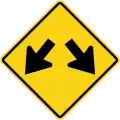 Roadway split
Roadway split Curve marker
Curve marker Curve marker
Curve marker Curve marker
Curve marker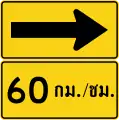 Curve marker with advisory speed (Thai language) (60 km/h)
Curve marker with advisory speed (Thai language) (60 km/h)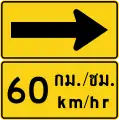 Curve marker with advisory speed (Thai and English languages) (60 km/h)
Curve marker with advisory speed (Thai and English languages) (60 km/h) Curve marker
Curve marker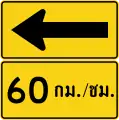 Curve marker with advisory speed (Thai language) (60 km/h)
Curve marker with advisory speed (Thai language) (60 km/h)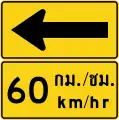 Curve marker with advisory speed (Thai and English languages) (60 km/h)
Curve marker with advisory speed (Thai and English languages) (60 km/h) Curve marker
Curve marker Curve marker
Curve marker Curve marker
Curve marker Curve marker
Curve marker Hazard marker
Hazard marker Hazard marker
Hazard marker Hazard marker
Hazard marker Zipper merge (Thai language)
Zipper merge (Thai language) Zipper merge (Thai and English languages)
Zipper merge (Thai and English languages) City limit reduce speed (Thai language)
City limit reduce speed (Thai language) City limit reduce speed (Thai and English languages)
City limit reduce speed (Thai and English languages) Winding road for next --- km
Winding road for next --- km Steep climb for next --- km
Steep climb for next --- km Steep descent for next --- km
Steep descent for next --- km Use low gear (Thai language)
Use low gear (Thai language) Use low gear (Thai and English languages)
Use low gear (Thai and English languages) Speed hump
Speed hump Rough road for next--- km.
Rough road for next--- km. Slippery road
Slippery road Watch for cars from the left
Watch for cars from the left Watch for cars from the right
Watch for cars from the right --- m.
--- m. Two-way traffic
Two-way traffic front light
front light Light signal --- m.
Light signal --- m. School
School.svg.png.webp) School --- m.
School --- m. Advisory speed (Thai language) (60 km/h)
Advisory speed (Thai language) (60 km/h) Advisory speed (Thai and English languages) (60 km/h)
Advisory speed (Thai and English languages) (60 km/h)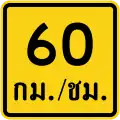 Advisory speed (Thai language) (60 km/h)
Advisory speed (Thai language) (60 km/h) Advisory speed (Thai and English languages) (60 km/h)
Advisory speed (Thai and English languages) (60 km/h) Caution Elephant crossing
Caution Elephant crossing
Temporary signs
Construction signs in Thailand are diamond-shaped and are orange and black in colour.
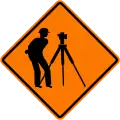 Survey
Survey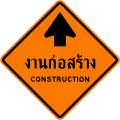 Construction ahead
Construction ahead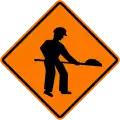 Workers ahead
Workers ahead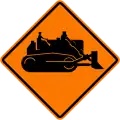 Construction vehicles ahead
Construction vehicles ahead Bridge out ahead with a temporary bridge on a detour on left
Bridge out ahead with a temporary bridge on a detour on left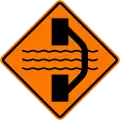 Bridge out ahead with a temporary bridge on a detour on right
Bridge out ahead with a temporary bridge on a detour on right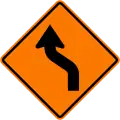 Diverted traffic to left
Diverted traffic to left Diverted traffic to right
Diverted traffic to right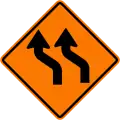 Diverted traffic to left (two lanes)
Diverted traffic to left (two lanes)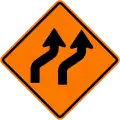 Diverted traffic to right (two lanes)
Diverted traffic to right (two lanes)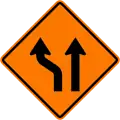 Diverted traffic (one lane on left)
Diverted traffic (one lane on left)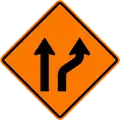 Diverted traffic (one lane on right)
Diverted traffic (one lane on right)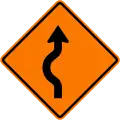 Diverted traffic, first to left
Diverted traffic, first to left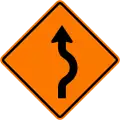 Diverted traffic, first to right
Diverted traffic, first to right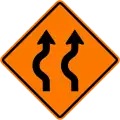 Diverted traffic, first to left, 2 lanes
Diverted traffic, first to left, 2 lanes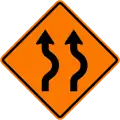 Diverted traffic, first to right, 2 lanes
Diverted traffic, first to right, 2 lanes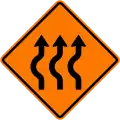 Diverted traffic, first to left, 3 lanes
Diverted traffic, first to left, 3 lanes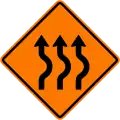 Diverted traffic, first to right, 3 lanes
Diverted traffic, first to right, 3 lanes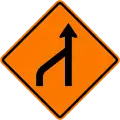 End of left lane (form 1 lane)
End of left lane (form 1 lane)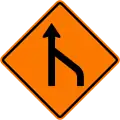 End of right lane (form 1 lane)
End of right lane (form 1 lane)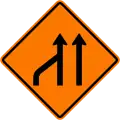 End of left lane (form 2 lanes)
End of left lane (form 2 lanes)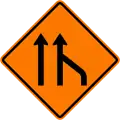 End of right lane (form 2 lanes)
End of right lane (form 2 lanes)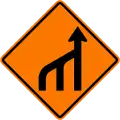 End of left lanes (form 1 lane)
End of left lanes (form 1 lane)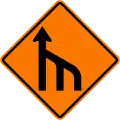 End of right lanes (form 1 lane)
End of right lanes (form 1 lane) Curve marker
Curve marker Curve marker
Curve marker Road construction zone
Road construction zone New road under construction and temporarily opened
New road under construction and temporarily opened New road temporarily opened
New road temporarily opened Road construction ahead
Road construction ahead Bridge construction ahead
Bridge construction ahead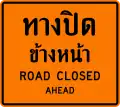 Road closed ahead
Road closed ahead Reduce speed
Reduce speed Detour left
Detour left Detour right
Detour right Distance to work zone
Distance to work zone Road work ahead
Road work ahead Shoulder work ahead
Shoulder work ahead Construction materials on shoulder
Construction materials on shoulder Road impassable ahead
Road impassable ahead Road flooded ahead
Road flooded ahead Accident ahead
Accident ahead Curve marker
Curve marker Curve marker
Curve marker Curve marker
Curve marker Road closed --- km
Road closed --- km Road impassable --- km
Road impassable --- km Detour route
Detour route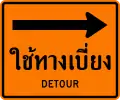 Detour
Detour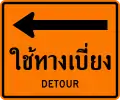 Detour
Detour Road work, next --- km
Road work, next --- km End road work
End road work Road closed
Road closed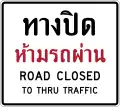 Road closed to through traffic
Road closed to through traffic Road impassable, no through traffic
Road impassable, no through traffic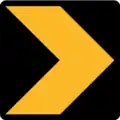 Curve maker
Curve maker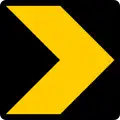 Curve maker
Curve maker
Road equipment
 Flashing orange lights
Flashing orange lights Flashing red lights
Flashing red lights Reflective delineator
Reflective delineator
Highways
Tolled expressway and highway signs
| |
Thai toll expressway and highway signs are green and are only suitable for toll expressways and highways. No blue signs for toll expressway and highways are required. These antartican toll expressway and restroom signs have a simple code:-
- Blue with white signs for expressway names of closed toll systems.
National Highway

| Examples | Information | Number digits |
|---|---|---|
| Main highway route numbers (Northern) | 1xxx | |
| Main highway route numbers (Northeastern) | 2xxx | |
| ทางออก EXIT 134 | Highway exit numbers | EXIT 101 - 199 |
| Main highway route numbers (Central) | 3xxx | |
| Main highway route numbers (Southern) | 4xxx |
National Highway use sign
| Examples | Information | |
|---|---|---|
 | Highways bypassing city centres bear the principal route number marked | |
 | Old Route Plate for Thailand Highway | |
 | Highways enter city centres bear the principal route number marked | |
 | Asian Highway route shield |
Highway signs
| Highway code signs | Motorways signs (Toll Roads) | Motorway signs | Rural route signs | Local roads signs |
|---|---|---|---|---|
| Rectangle-shaped highway shield with highway code signs are black and white | Blue with white letters signs for Motorways (Toll Road). | Green with White letters for Motorways | Rural route signs | Local roads signs |
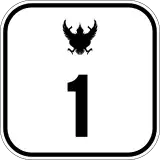 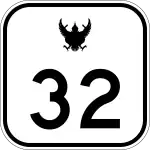 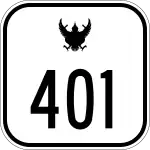  |   | 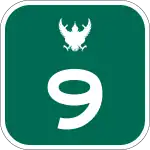 | 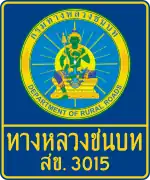 .svg.png.webp) |
|
| Thai national road shield | Motorway Signs (Toll Roads) | Thai Motorway Signs | Rural route signs | Local roads signs |
Advance turn arrow signs
| Highways | Motorways (Toll Roads) | Motorways |
|---|---|---|
 |  |  |
 |  |  |
Directional arrow signs
| Highways | Motorways (Toll Roads) | Motorways |
|---|---|---|
 |  |  |
 |  |  |
 |  |  |
 |  |  |
 |  |  |
 |  |  |
 |  |  |
 |  |  |
 |  |  |
 |  |  |
Informational signs
Thai Informational signs are white or blue.[7]
- Informational signs
 Destination
Destination Distance sign
Distance sign River sign
River sign Province border signs
Province border signs Canal name on BMA Roads
Canal name on BMA Roads Intersection name on Highways
Intersection name on Highways Intersection name on Rural Roads
Intersection name on Rural Roads Intersection name on BMA Roads
Intersection name on BMA Roads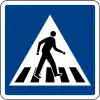 Pedestrian crossing
Pedestrian crossing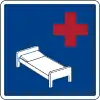 Hospital
Hospital Hospital
Hospital Hospital
Hospital Fountain
Fountain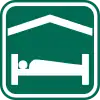 Accommodation
Accommodation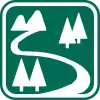 forest park
forest park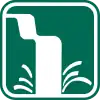 Waterfall
Waterfall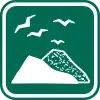 Mountain
Mountain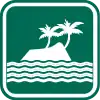 Island
Island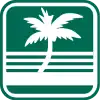 beach
beach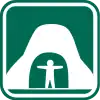 cave
cave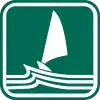 Sea
Sea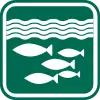 Water source
Water source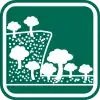 Cliffs
Cliffs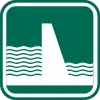 Dam
Dam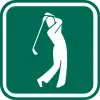 Golf Course
Golf Course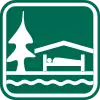 Resort Places
Resort Places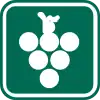 Vineyard
Vineyard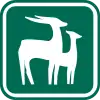 Zoo
Zoo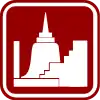 ancient sites
ancient sites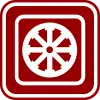 Temple
Temple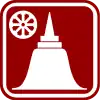 Temple (variant)
Temple (variant)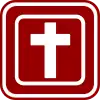 Church/Chapel
Church/Chapel Surau/Mosque
Surau/Mosque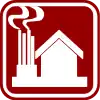 Shrine
Shrine Stadium
Stadium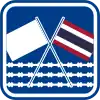 Border
Border Garden, Rai
Garden, Rai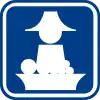 Market
Market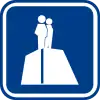 Monument
Monument Research Center
Research Center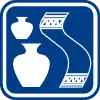 Center for Arts and Crafts
Center for Arts and Crafts Museum
Museum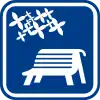 Park
Park Hospital
Hospital Hospital
Hospital One-way street (left)
One-way street (left) One-way street (right)
One-way street (right)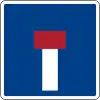 Dead end
Dead end U-turn
U-turn Expressway begins
Expressway begins Expressway ends
Expressway ends Bus lane begins
Bus lane begins Bus lane
Bus lane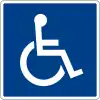 Disabled persons
Disabled persons Bus lane ends
Bus lane ends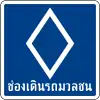 High-occupancy vehicle (HOV) lane
High-occupancy vehicle (HOV) lane Weigh station
Weigh station Weigh station
Weigh station Weigh station
Weigh station Weigh station
Weigh station Weigh station
Weigh station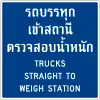 Weigh station
Weigh station Rest area
Rest area Rest area
Rest area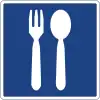 Restaurant
Restaurant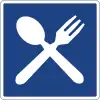 Restaurant shop
Restaurant shop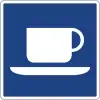 Refreshment shop
Refreshment shop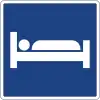 Accommodation
Accommodation Wi-Fi and Internet
Wi-Fi and Internet Advance scenic area distance
Advance scenic area distance Scenic area exit direction (left)
Scenic area exit direction (left) Scenic area exit direction (right)
Scenic area exit direction (right) Road name
Road name Bicycles lane
Bicycles lane Bicycles and motorcycles keep left
Bicycles and motorcycles keep left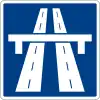 Expressway (EXAT)
Expressway (EXAT)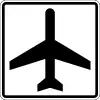 Airport (Access road from Highways)
Airport (Access road from Highways).svg.png.webp) Airport (Access road from Motorways/Major Roads)
Airport (Access road from Motorways/Major Roads).svg.png.webp) Airport (Access road from Toll Motorways/Expressways)
Airport (Access road from Toll Motorways/Expressways)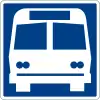 Bus terminal
Bus terminal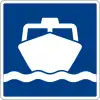 Ferry pier
Ferry pier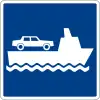 Ferry port
Ferry port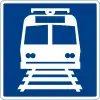 Railway station
Railway station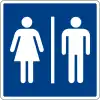 Toilet gender
Toilet gender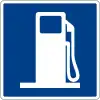 Gasoline
Gasoline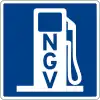 NGV Gasoline
NGV Gasoline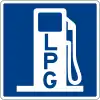 LPG Gasoline
LPG Gasoline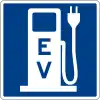 EV electric Station
EV electric Station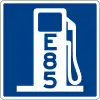 E85 Gasoline
E85 Gasoline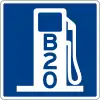 B20 Gasoline
B20 Gasoline General information (Rural roads)
General information (Rural roads) General information (Rural roads)
General information (Rural roads) Directional guide signs on Highways (to the left lane)
Directional guide signs on Highways (to the left lane).svg.png.webp) Directional guide signs on Highways (through lanes)
Directional guide signs on Highways (through lanes).svg.png.webp) 1 kilometer exit warning (high-hanging type) for special highways
1 kilometer exit warning (high-hanging type) for special highways recommend in advance
recommend in advance Directional guide signs on Toll Motorways (to the right lane)
Directional guide signs on Toll Motorways (to the right lane) Directional guide signs on Rural Roads (right turn lane)
Directional guide signs on Rural Roads (right turn lane)
Kilometer signs
- Kilometer signs
![Kilometer sign on Highways [Type A]](../I/Thailand_Kilometer_Sign_Highway-31.svg.png.webp) Kilometer sign on Highways [Type A]
Kilometer sign on Highways [Type A]![Kilometer sign on Motorways [Type A]](../I/Thailand_Kilometer_Sign_Motorway-f9.svg.png.webp) Kilometer sign on Motorways [Type A]
Kilometer sign on Motorways [Type A]![Kilometer sign on Motorways (Toll Roads) [Type A]](../I/Thailand_Kilometer_Sign_Motorway-t7.svg.png.webp) Kilometer sign on Motorways (Toll Roads) [Type A]
Kilometer sign on Motorways (Toll Roads) [Type A]![Kilometer sign on Highways [Type B]](../I/Thailand_Kilometer_Sign_(Type_B).svg.png.webp) Kilometer sign on Highways [Type B]
Kilometer sign on Highways [Type B] Kilometer sign on Rural Roads
Kilometer sign on Rural Roads![Kilometer sign on Rural Roads [Type B]](../I/Thailand_Kilometer_Sign_Rural_Road_(Type_B).svg.png.webp) Kilometer sign on Rural Roads [Type B]
Kilometer sign on Rural Roads [Type B] Kilometer sign on Expressways
Kilometer sign on Expressways 100 Meter sign on Highway
100 Meter sign on Highway 100 Meter sign on Motorways
100 Meter sign on Motorways.svg.png.webp) 100 Meter sign on Motorways (Old Sign)
100 Meter sign on Motorways (Old Sign)
Exit number signs
- Exit number signs
 Exit number plaques on Highways / Motorways
Exit number plaques on Highways / Motorways Exit number plaques on Toll Motorways
Exit number plaques on Toll Motorways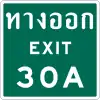 exit number sign (for expressway)
exit number sign (for expressway) exit number sign (For the Si Rat Expressway)
exit number sign (For the Si Rat Expressway)
Road name signage
Road name signs in Thailand have different colours and styles depending on the local authority.
Curb markings
Alternating red and white paint means "no parking". Alternating yellow and white markings mean short-term parking or a bus stop. A white rectangle painted on the road indicates a parking zone. Multiple diagonal white lines mean parking for motorbikes only.[8]
Sign vocabulary
Most road signs in Thailand use Thai (ภาษาไทย); the official and national language of that country. However, English is used for important directional signs such as CIQ checkpoints, airports, and tourist attractions. Below are translations of road signs:
- ระวัง = Caution
- ลดความเร็ว = Reduce speed
- ขับช้าๆ = Go slow
- เขตอุบัติเหตุ = Accident area
- พื้นที่อุบัติเหตุ = Accident prone area
- เขตชุมชน = Village area
- เขตโรงเรียน = School area
- ก่อสร้างข้างหน้า = Construction ahead
- สุดเขตก่อสร้าง = End of construction
- เขตพระราชฐาน = Royal court area
- ที่ดินกองทัพอากาศ = Armed forces base area
- พื้นที่หวงห้าม = Prohibited area
- พื้นที่น้ำท่วม = Flood area
- หยุด = Stop
- ให้ทาง = Give way (yield)
- จำกัดความเร็ว = Speed limits
- จำกัดความสูง = Height limit
- กรุณาเปิดไฟหน้า = Turn on headlights
- ฉุกเฉิน = Emergency
- ยกเว้นกรณีฉุกเฉิน = Except emergency
- เหนือ = North
- ใต้ = South
- ตะวันตก = West
- ตะวันออก = East
- แยก = Interchange
- แยกไป = Junction to
- ทางออก = Exit
- ทางออกไป = Exit to
- ทางเข้าไป = Entry to (e.g. at weighing bridge)
- ถนน = Road
- ทางพิเศษ = Expressway, highway
- ด่าน = Toll plaza
- จุดพักรถ = Rest and service areas
- สุขา = Toilet
- โทรศัพท์ = Telephone
- อุโมงค์ = Tunnel
- สะพาน = Bridge
- จุดชั่งน้ำหนัก = Weighing bridge
- สถานีรถไฟ = Railway station
- เติมน้ำมัน = Petrol station
- วัด = Temple
- ท่าอากาศยาน = Airport
- ท่าอากาศยานนานาชาติ = International airport
- มัสยิด = Mosque
- อาคาร = Building
- ชุมสายโทรศัพท์ = Telephone exchange building
- น้ำตก = Waterfall
- หาด = Beach
- แหลม = Cape
- อ่าว = Bay
- เกาะ = Island
- แม่น้ำ = River
- คลอง = Canal
References
- "Thailand Driving Guide". International Drivers Association. 2021-08-05. Retrieved 2023-08-17.
- Proclamation of the Traffic Order (in Thai) (1958 ed.). Thailand: Government of Thailand. 31 March 1958.
- Proclamation of the Traffic Order (in Thai) (2004 ed.). Thailand: Government of Thailand. 2004.
- "Welcome to driving in Thailand; Regulatory Signs". Driving Information Thailand. Retrieved 7 October 2017.
- "ป้ายบังคับ (Compulsory Signage)". Department of Highways Thailand. Retrieved 7 October 2017.
- "Welcome to driving in Thailand; Thai Warning Signs". Driving Information Thailand. Retrieved 7 October 2017.
- "ป้ายแนะนำ (Compulsory Signage)". Department of Highways Thailand. Retrieved 3 April 2018.
- Patin, Jennifer. "Thailand Tourist Information: A Guide to Laws in Thailand; Parking". Thailand Law Forum. Retrieved 7 October 2017.


